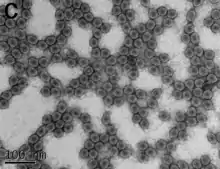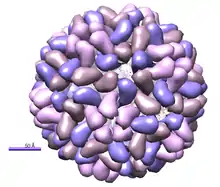Brome mosaic virus
Brome mosaic virus (BMV) is a small (28 nm, 86S), positive-stranded, icosahedral RNA plant virus belonging to the genus Bromovirus, family Bromoviridae, in the Alphavirus-like superfamily.
| Brome mosaic virus | |
|---|---|
 | |
| Transmission electron micrograph of brome mosaic virus (BMV) virions | |
 | |
| Crystal structure of Brome mosaic virus, PDB entry 1js9[1] | |
| Virus classification | |
| (unranked): | Virus |
| Realm: | Riboviria |
| Kingdom: | Orthornavirae |
| Phylum: | Kitrinoviricota |
| Class: | Alsuviricetes |
| Order: | Martellivirales |
| Family: | Bromoviridae |
| Genus: | Bromovirus |
| Species: | Brome mosaic virus |
BMV was first isolated in 1942 from bromegrass (Bromus inermis),[2] had its genomic organization determined by the 1970s, and was completely sequenced with commercially available clones by the 1980s.[3][4]
The alphavirus-like superfamily includes more than 250 plant and animal viruses including Tobacco mosaic virus, Semliki forest virus, Hepatitis E virus, Sindbis virus, and arboviruses (which cause certain types of encephalitis).[5][6] Many of the positive-strand RNA viruses that belong to the alphavirus family share a high degree of similarity in proteins involved in genomic replication and synthesis.[7][8] The sequence similarities of RNA replication genes and strategies for BMV have been shown to extend to a wide range of plant and animal viruses beyond the alphaviruses, including many other positive-strand RNA viruses from other families.[9] Understanding how these viruses replicate and targeting key points in their life cycle can help advance antiviral treatments worldwide.
Genome
BMV has a genome that is divided into three 5' capped RNAs. RNA1 (3.2 kb) encodes a protein called 1a (109 kDa), which contains both an N-proximal methyltransferase domain and a C-proximal helicase-like domain. The methyltransferase domain shows sequence similarity to other alphavirus m7G methyltransferases and guanyltransferases, called nsP1 proteins, involved in RNA capping.[10] RNA2 (2.9 kb) encodes the 2a protein (94 kDa), the RNA-dependent RNA polymerase, responsible for replication of the viral genome.[9][5] The dicistronic RNA3 (2.1 kb) encodes for two proteins, the 3a protein (involved in cell-to-cell migration during infection) and the coat protein (for RNA encapsidation and vascular spread), which is expressed from a subgenomic replication intermediate mRNA, called RNA4 (0.9 kb). 3a and coat protein are essential for systemic infection in plants but not RNA replication.[11][5][12]
Hosts and symptoms
BMV commonly infects Bromus inermis (see Bromus) and other grasses, can be found almost anywhere wheat is grown It is also one of the few grass viruses that infects dicotyledonous plants, such as soybean;[13] however, it primarily infects monocotyledonous plants, such as barley and others in the family Gramineae. The diagnostic species of this disease is maize, where seedlings show a variety of symptoms of this diseases, (dpvweb.net). Its propagation species is barley, which displays a mild mosaic. The assay species of this disease is Chenopodium Hybridum, (dpvweb.net). The symptoms of BMV are similar to most mosaic viruses. The symptoms consist of stunted growth, lesions, mosaic leaves, and death, (researchgate.net). These symptoms generally appear around 10 days after germination of the host plant. The symptoms of this disease affect maize and barley plants the most.
In 2015, it was found that BMV had coinfected Triticale with Wheat Streak Mosaic Virus. This was the first report of coinfection between those two viruses and raises and the first report of BMV infecting Triticale. This raises questions on whether or not the two viruses share a common vector and how they interact with each other. They are currently researching further into this occurrence (K. Trzmiel, 2015).
Management
As of now there is no treatment for this virus once the plant has been infected. There are only measures of prevention of this disease. One option is to use a strain of plant that is resistant to this virus. Since this is a virus fungicides will have no effect on the spread or infection of this disease. Make sure to remove all perennial weeds in the area and to use insecticide to help kill vectors of this disease, (plantnatural.com). Make sure to clean equipment and hands before contact with plants. Lastly, removal of infected plants is crucial to the health of surrounding plants and is key to stopping the spread of this disease, (Wheat Streak Mosaic Virus on Wheat: Biology and Management). There are currently no biological control methods to combat this virus. It has been found that the most effective way to combat this virus is to use strains of crop that have resistance to this virus and to use pesticides to remove any vectors that could carry this disease because one of the number one causes of this disease vectors transmitting it to multiple plants after taking up the virus.
Environment and importance
Environments that are most suitable for this disease are generally damp because viruses are transmitted easier when the plants are wet. It is also found in areas that have a heavy amount of wheat plants present and where there is a lot of human contact or exposure Humans are one of the most common vectors used to spread this disease. The temperature range at which this disease is most infective at 20°C to 36°C, according to “Plant Viruses” on page 417. There are multiple vectors for this virus. The vector that is most associated with this disease is the Oulema melanopus L. beetle, (agroatlas.ru). This beetle is found over a large portion of the Midwest and is one of the biggest carriers of this pathogen. The importance of this disease is it can severely reduce yield of the host plants and the fact it has a wide variety of host plants that it infects. In as study performed in Ohio, they found that the BMV can reduce yield by as much as 61% in soft red winter wheat. The findings found in the Ohio study suggest that Brome Mosaic Virus might have a greater impact on wheat production than previously thought (Hodge, 2018). Farmers have to take great measures to prevent and contain this virus in order to ensure that they produce a quality crop with maximum yield, (Stabilization of Brome Mosaic Virus, page 99-101).
References
- Lucas, R. W.; Larson, S. B.; McPherson, A. (2002). "The crystallographic structure of Brome mosaic virus". Journal of Molecular Biology. 317 (1): 95–108. doi:10.1006/jmbi.2001.5389. PMID 11916381.
- Lane, L. C. (1974). "The bromoviruses". Advances in Virus Research Volume 19. Advances in Virus Research. 19. pp. 151–220. doi:10.1016/s0065-3527(08)60660-0. ISBN 9780120398195. PMID 4613160.
- Ahlquist, P.; Luckow, V.; Kaesberg, P. (1981). "Complete nucleotide sequence of brome mosaic virus RNA3". Journal of Molecular Biology. 153 (1): 23–38. doi:10.1016/0022-2836(81)90524-6. PMID 7338913.
- Lane, 2003
- Sullivan & Ahlquist, 1997
- Lampio, 1999
- Ahlquist, P.; Strauss, E. G.; Rice, C. M.; Strauss, J. H.; Haseloff, J.; Zimmern, D. (1985). "Sindbis virus proteins nsP1 and nsP2 contain homology to nonstructural proteins from several RNA plant viruses". Journal of Virology. 53 (2): 536–542. doi:10.1128/JVI.53.2.536-542.1985. PMC 254668. PMID 3968720.
- French, R.; Ahlquist, P. (1988). "Characterization and engineering of sequences controlling in vivo synthesis of brome mosaic virus subgenomic RNA". Journal of Virology. 62 (7): 2411–2420. doi:10.1128/JVI.62.7.2411-2420.1988. PMC 253399. PMID 3373573.
- Ahlquist, P. (1992). "Bromovirus RNA replication and transcription". Current Opinion in Genetics & Development. 2 (1): 71–76. doi:10.1016/S0959-437X(05)80325-9. PMID 1378769.
- Ahola, T.; Ahlquist, P. (1999). "Putative RNA capping activities encoded by brome mosaic virus: Methylation and covalent binding of guanylate by replicase protein 1a". Journal of Virology. 73 (12): 10061–10069. doi:10.1128/JVI.73.12.10061-10069.1999. PMC 113057. PMID 10559320.
- Sacher, R.; Ahlquist, P. (1989). "Effects of deletions in the N-terminal basic arm of brome mosaic virus coat protein on RNA packaging and systemic infection". Journal of Virology. 63 (11): 4545–4552. doi:10.1128/JVI.63.11.4545-4552.1989. PMC 251087. PMID 2795712.
- Diez, J.; Ishikawa, M.; Kaido, M.; Ahlquist, P. (2000). "Identification and characterization of a host protein required for efficient template selection in viral RNA replication". Proceedings of the National Academy of Sciences. 97 (8): 3913–3918. Bibcode:2000PNAS...97.3913D. doi:10.1073/pnas.080072997. PMC 18116. PMID 10759565.
- Díaz-Cruz, G.A.; Smith, C.M.; Wiebe, K.F.; Charette, J.M.; Cassone, B.J. (2018). "First Report of Brome mosaic virus Infecting Soybean, Isolated in Manitoba, Canada". Plant Disease. 102 (2): 460. doi:10.1094/PDIS-07-17-1012-PDN.
- Antoniw, John. Show DPV and Refs in Frame, www.dpvweb.net/dpv/showdpv.php?dpvno=180.
- Charles J. Sailey. Portion of thesis entitled Characterization of Brome Mosaic Virus RNA3 interaction with GCD10, a tRNA binding host factor from yeast. 2005. University of the Sciences in Philadelphia.
- Hadi, B.a.r., et al. “Wheat Streak Mosaic Virus on Wheat: Biology and Management.” Journal of Integrated Pest Management, vol. 2, no. 1, Jan. 2011, doi:10.1603/ipm10017.
- Hodge, Brian A., et al. “Characterization of an Ohio Isolate of Brome Mosaic Virus and Its Impact on the Development and Yield of Soft Red Winter Wheat.” Plant Disease, 10 Oct. 2018, doi:10.1094/pdis-07-18-1282-re.
- “Mosaic Virus: Symptoms, Treatment and Control.” Planet Natural, www.planetnatural.com/pest-problem-solver/plant-disease/mosaic-virus/.
- Nayudu, M V. Plant Viruses. 2008.
- Research Gate, www.researchgate.net/figure/Symptoms-induced-by-the-fescue-strain-of-Brome-mosaic-virus-F-BMV-on-tall-fescue_fig1_6723665.
- Trzmiel, K., et al. “First Report of Brome Mosaic Virus (BMV) and Wheat Streak Mosaic Virus (WSMV) Co-Infection in Triticale Plants in Poland.” Plant Disease, vol. 99, no. 9, 2015, pp. 1290–1290., doi:10.1094/pdis-01-15-0105-pdn.
- Tsyplenkov, A. “Diseases.” AgroAtlas - Relatives - Agropyron Cristatum (L). Gaertn. - Crested Wheat Grass., 2018, www.agroatlas.ru/en/content/diseases/Gramineae/Gramineae_Brome_mosaic_virus/index.html.
- User, Super. “Brome Mosaic Virus (BMV).” Wheat Doctor, wheatdoctor.org/brome-mosaic-virus-bmv.